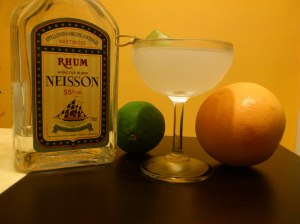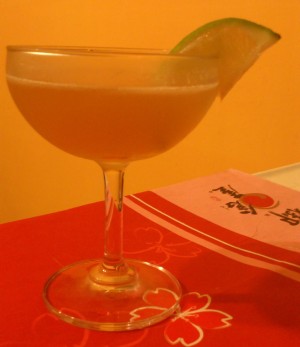Doing Daiquiris
September 1, 2012
My list of favourite drinks just keeps going up, but for quite some time one definite item is the Daiquiri.
 (Let’s just get this out of the way: I don’t mean those ‘Frozen Daiquiris’ which are sweet smoothy-style drinks of rum, cointreau, lime, sugar and some fruit blended up and served ice and all – those can actually be nice, refreshing and fun, but a ‘true’ Daiquiri is something nice simple and pure.)
(Let’s just get this out of the way: I don’t mean those ‘Frozen Daiquiris’ which are sweet smoothy-style drinks of rum, cointreau, lime, sugar and some fruit blended up and served ice and all – those can actually be nice, refreshing and fun, but a ‘true’ Daiquiri is something nice simple and pure.)
So rum, lime and sugar. That’s it really. From there it’s just proportions and subtle changes that make for the large number of variations that I’ve been ‘researching’ on and off for the last couple of months.
Rum and lime (and the sugar to balance it) are magical companions. I already blogged about how I loved the Ti’ Punch which is this combo with Rhum Agricole instead of normal rum, and the Caipirinha which is the same again with Cachaça instead of rum. Add to that the Mojito – that extremely popular and delicious drink which got me into cocktails two years ago in the first place – and you have a pretty mean arsenal of killer drinks which are basically rum, lime and sugar.
Given that rum, lime and sugar have all been abundant in the Carribean for centuries, it may come as a surprise that the Daiquiri wasn’t invented until around 1900 and that the discovery was made by American mine engineers who had run out of gin. Well, of course it wasn’t, but it does illustrate that it’s creating a name for a drink that counts and making that drink popular that makes it stick. The engineers named the Daiquiri after a beach near Santiago in Cuba, and ten years or so later it was brought back to the US where it became fairly popular for a few more decades and then really popular in the 40s and 50s when whiskey became scarce due to wartime rationing. Famous Daiquiri devotees from this time include John F Kennedy and Ernest Hemingway.
As I said, rum, lime and sugar – that’s it. And now to the fine print. It’s a Cuban drink, so Cuban rum is what’s called for, and it’s generally the white stuff (exceptions will follow). I love my Havana Club, but Cuba won’t sell it to imperialists or something, so drinkers in the US can’t get it. I also think Matusalem Platino (from the Dominican Republic) makes a great traditional Daiquiri and I’ve heard Brughal (also Dominican)can make a good substitute too, but I haven’t tried it myself so I can’t vouch for it. Neither Bacardi nor Angostura make the grade, I’m afraid.
The other main negotiable is the proportions. I tried quite a lot before I settled on my ideal. It’s not a gold standard. Some rums are sweeter than others; some limes more sour. But for me, it’s a solid starting position. I must say though, that I have discovered (from my one little try at bar-tending) that my tastes may well be a lot more sour than those of the majority. My wife is the same way, so that’s the way I make them. Here’s my proportions and basic Daiquiri recipe, then:
2 oz rum (white, Cuban)
1 oz freshly-squeezed lime juice
1 tsp sugar
Stir the sugar in the lime juice to dissolve it (I use super-fine – variations possible). Add ice (crushed is good) and rum. Shake well. Serve either strained into a chilled cocktail glass or frappe over crushed ice (or in a highball glass of crushed ice, or a rocks glass with ice cubes – it’s all good).
Straight-up is nice, but I really like this with crushed ice on a hot evening. That’s another way to vary this very versatile drink.
If you have a sweet tooth, add more sugar (or just harden up a bit).
Daiquiri with bitters
I messed around a bit adding bitters to my Daiquiris. It’s not a drink that normally calls for bitters, but it can make a nice variation.
Chocolate: I think a little chocolate bitters (I used The Bitter Truth) goes quite nicely with the vanilla-caramel tastes of the Matusalem, for a smooth beginners mix which I call the Mellow Daiquiri.
Rhubarb: This is refreshing (I used Fees), especially with the interesting version of Rhum Agricole (more about that in a minute).
Grapefruit and Cherry: I used both of these (Fees: 2 dashes grapefruit, 1 dash cherry) with maraschino in a Papa Doble, and they were excellent. What’s a Papa Doble? More about that later. OK, more about that now.
Papa Doble Daiquiri aka Hemingway Daiquiri aka La Floridita, aka La Florida Daiquiri
So Ernest Hemingway walked into a Cuban bar where they were trying out a new Daiquiri recipe. He liked it and ended up drinking his Daiquiris exclusively at the bar – La Florida (nicknamed La Floridita). The barman made a new recipe just for him and/or one he named for him. Pretty soon there were a bunch of ‘Hemingway’ Daiquiri recipes floating about, one or more of which may have been the one that he actually drank.
These recipes all have maraschino liqueur, and most have grapefruit juice too, which seems to be the way Hemingway drank them. Most recipes have sugar or syrup, but Ernest most likely skipped that (maybe because fo his diabetes). There seems to be a lot of debate about which is the authentic recipe, but it doesn’t really seem particularly important to me.
I played around with quantities quite a bit until I got the proportions I liked.
1/2 oz lime
3/4 oz grapefruit juice
1/2 tsp maraschino liqueur
1 tsp sugar
Dissolve the sugar in the lime juice. Shake all ingredients with crushed ice and strain into a rocks glass or cocktail glass of crushed ice. Garnish with a lime wheel and a cherry.
Most recipes seem to have more maraschino, and the ones that include grapefruit tend to have equal parts with the lime, but these are the proportions that worked for me. I like marashcino, but too much (which means more than a tiny bit) over-powers a drink. I like grapefruit juice a lot, but as its sourness is less than lemon or lime, you need to balance between getting enough sourness and weakening the drink too much.
Apparently they used a blender at La Floridita, but that doesn’t mean they made it like a slushy-Daiquiri. They blended briefly then strained that onto fresh crushed ice. I think you can do just as well without blending.
As mentioned above, I like a variation I made without grapefruit juice, but with (Fees) grapefruit bitters and cherry bitters:
1 oz lime juice
1/2 tsp maraschino liqueur
2 dashes grapefruit bitters
1 small dash cherry bitters
I liked this one a lot, but others didn’t. Too sour, I think.
Finally, in Jason Wilson’s book Boozehound, which I admire a lot, he has this Papa Doble:
2 oz rhum agricole
1/2 oz lime juice
1/2 oz grapefruit juice
1 tsp maraschino liqueur
I’ve talked about how much I like (Neissons) rhum agricole before. This makes for a delicious, but very different Daiquiri. I mean, I hesitate to even call it a Daiquiri. It’s closer to a souped-up ‘Ti Punch really, the agricole is that different. The extra maraschino compared to the previous recipes works, because the agricole is so powerful. As I mentioned, I tried an agricole Daiquiri (without maraschino) with rhubarb bitter s as well, and it’s also fantastic. I’ve made this a few times now (with Neissons) and if you like some strong funky flavour, I recommend it highly.
s as well, and it’s also fantastic. I’ve made this a few times now (with Neissons) and if you like some strong funky flavour, I recommend it highly.
More Variations
The Daiquiri is essentially a sour – spirits, sugar, lemon/lime and ice. Cocktail maven Gary Regan coined the phrase ‘New Orleans Sour’ for sours which substitutes Curacao for the sugar. Examples are the Margarita, Sidecar and Cosmopolitan. Giving the Daiquiri this treatment (and sub in grapefruit for lime) produces this:
1 oz rum
1 oz Cointreau
1 oz grapefruit
Shake and strain into a cocktail glass.
This was too sweet. Double the rum and halve the Cointreau for a much better drink. The rum then shines through, the Cointreau definitely adds to and the grapefruit … well, I’m not sure it quite works – maybe it would be better strengthened with a little lime.
I love Cointreau, king of the Curacaos. Some think it too sweet, but I think it’s a delicious sweetness that is not at all sickly. I could gladly sip Cointreau straight from the bottle all night, ice only improves it, and it’s aces in cocktails. Spirits guru extraordinaire F. Paul Pacult names it as one of his five desert island bottles.
It makes this drink quite a refined cocktail, but possibly a little too light-weight.
The next one substitutes grenadine for sugar as the sweetening agent, and was once a popular enough drink to attract law suits.
2 oz white rum
1 oz lime juice
1 tsp grenadine
Shake and strain into a cocktail glass.
This is a great cocktail. I love grenadine (it has to be homemade, though) and this, even more than the Jack Rose, is the perfect drink for it.
The name? Well it used to be made with Bacardi, but that was back when Bacardi was actually Cuban and tasted that way too. Do you know what Cubans mean when they say “Bacardi”? They mean Caney – the rum that’s now made in the old Bacardi distillery.
That didn’t help certain restauranteurs back in 1934 New York, though. Back then the Bacardi cocktail was immensely popular and they got sued for using other rum. In a decision which in my mid is akin to outlawing martinis made with vermouth other than Martini & Rosso, they lost.
I get this information from How’s Your Drink, by Eric Felten, and he supplies this variation which I have yet to try, but looks great:
1 1/2 oz white rum
3/4 oz gin
juice of 1/2 lime
2 tsp grenadine
While I was ‘researching’ this article, well-known cocktail blogger Jeffrey Morgenthaler posted this great video with yet another Daiquiri variant, this time with dark rum.
2 1/2 oz dark rum
3/4 oz lime juice
1/2 oz simple syrup (made with 2:1 sugar to water)
Shake and strain into a cocktail glass.
I tried it. It was great. It almost changed my mind completely about Daiquiris. After some thought (and trying a few more), I concluded that for a summer refresher the original recipe is still best, with crushed ice, but for cooler weather this dark rum variation, served straight up, is the way to go.
That’s about it for Daiquiris – a great classic drink, especially in the heat. There is one more variation I’d like to talk about, one close to my heart, but I’ll save that for next post. It’s the variety with mint and a splash of soda.






